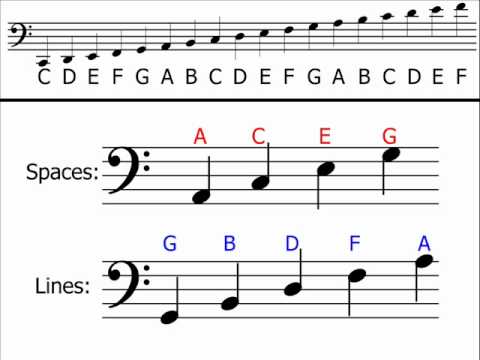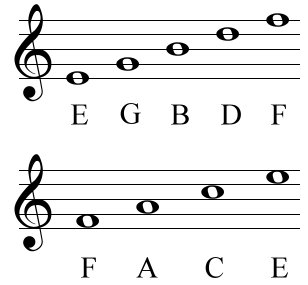Love us? Help us out and share!
Learning to play the piano can be a lot easier if you're able to read the sheet music to the song you're hearing. Being able to read notes grants you the ability to visualize the music you hear and render it onto the piano more effectively.
The two main sets of horizontal lines are called staffs.
The top is the Treble clef  (played with the right hand), representing all the notes above Middle C, and the bottom is the Bass clef
(played with the right hand), representing all the notes above Middle C, and the bottom is the Bass clef  (played with the left hand), representing all the notes below Middle C.
(played with the left hand), representing all the notes below Middle C.
The vertical lines which split up the staffs are called bar lines  while the sections they construct are the measures.
while the sections they construct are the measures.
Focusing on the notes now, we'll begin at the bottom of the bass clef and work our way up into the treble clef.
Starting at the bottom LINE and moving up, the notes are G, B, D, F, and A. A saying to remember these is (G)ood (B)oys (D)eserve (F)udge (A)lways.
The SPACES in between these notes are A, C, E, and G. A phrase to help remember these notes is (A)ll (C)ows (E)at (G)rass.
The note at the top invisible line is Middle C (played with the right hand's thumb), which divides the two staffs.

Now we'll move up to the treble Clef. Continuing to the notes placed on the LINES, these are E, G, B, D, and F. A good way to remember this is to change the previous phrase around into (E)very (G)ood (B)oy (D)eserves (F)udge.
The notes that fall into the relative SPACES in between are called F, A, C, and E. This is easy to remember because it spells FACE.

Now you know almost all the notes, but we're still missing some! In order to make a note sharp  you place a '#' on the left side of it. To play this you move up the scale - or to the right - from the original note by half a note (usually to a black key).
you place a '#' on the left side of it. To play this you move up the scale - or to the right - from the original note by half a note (usually to a black key).
In order to make a note flat , you would place the simble looking like 'b' to the left of it. To play this you move down the scale - or to the left - of the original note by half a note.
, you would place the simble looking like 'b' to the left of it. To play this you move down the scale - or to the left - of the original note by half a note.
Congrats! You now know all the basics to reading piano sheet music. Time to get practicing!
